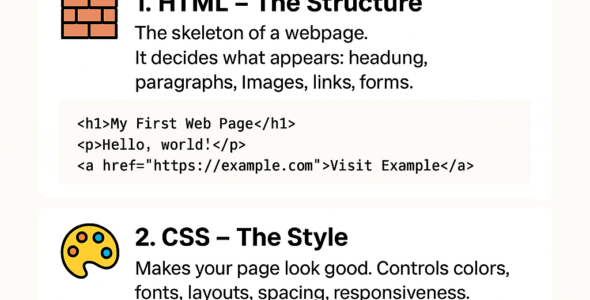Javascript Error Handling and Debugging with syntax and examples
Error Handling:
- Error handling is the process of anticipating, detecting, and resolving errors in a web application.
- Error handling ensures that web applications can handle unexpected situations and provide a better user experience.
- Error handling uses try-catch blocks, error objects, and error events to handle errors.
Try-Catch Blocks:
- Try-catch blocks are used to wrap code that might throw an error.
- Try-catch blocks consist of a try block and a catch block.
- The try block contains the code that might throw an error.
- The catch block contains the code that handles the error.
Syntax:
- Try-catch block:
- try { code } catch (error) { code }
Example:
- Try-catch block:
try {
// Code that might throw an error
const data = JSON.parse('invalid JSON');
} catch (error) {
// Code that handles the error
console.error(error);
}
Error Objects:
- Error objects provide information about the error.
- Error objects have properties such as message, name, and stack.
- Error objects can be used to provide more detailed error messages.
Syntax:
- Error object:
- const error = new Error('message');
Example:
- Error object:
try {
// Code that might throw an error
const data = JSON.parse('invalid JSON');
} catch (error) {
// Code that handles the error
console.error(error.message); // Output: Unexpected token i in JSON at position 0
}
Error Events:
- Error events are triggered when an error occurs.
- Error events can be used to handle errors globally.
- Error events can be used to provide a fallback mechanism for handling errors.
Syntax:
- Error event:
- window.addEventListener('error', (event) => { code });
Example:
- Error event:
window.addEventListener('error', (event) => {
// Code that handles the error
console.error(event.message); // Output: Unexpected token i in JSON at position 0
});
Debugging:
- Debugging is the process of identifying and fixing errors in a web application.
- Debugging uses tools such as the browser's developer tools, console logs, and debuggers.
- Debugging ensures that web applications are stable and provide a good user experience.
Syntax:
- Console log:
- console.log('message');
- Debugger:
- debugger;
Example:
- Debugging:
// Console log
console.log('Hello World!'); // Output: Hello World!
// Debugger
debugger;
// Code execution will stop here, and the debugger will be activated.
By mastering error handling and debugging, you will be able to write robust and stable web applications that provide a good user experience. Remember to practice and experiment with different examples to solidify your understanding.
